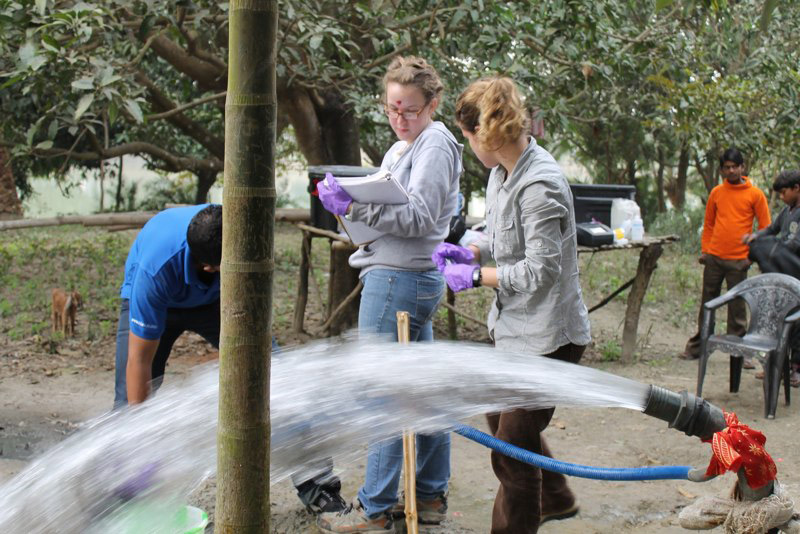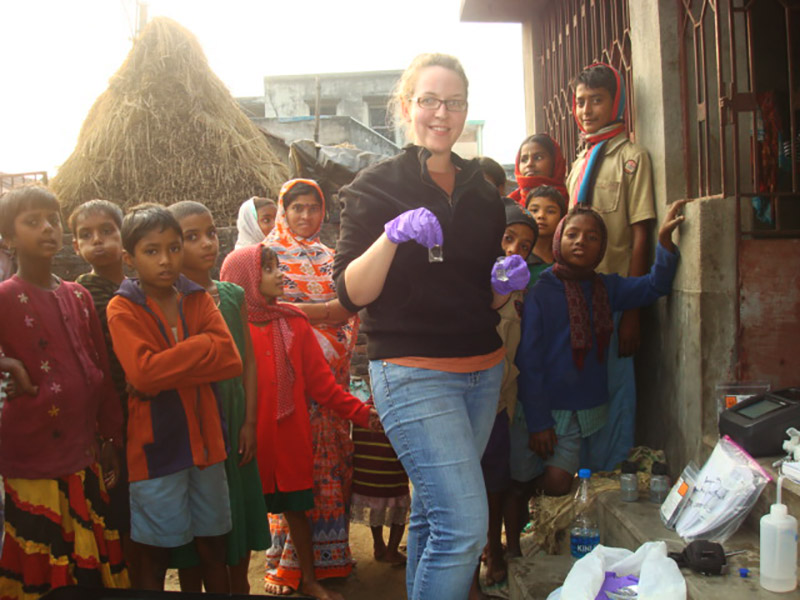The Indian state of West Bengal, located in eastern India and stretching from the Himalayas to the Bay of Bengal, is a cultural hub where art and literacy flourished. This landscape is dominated by winding rivers and luscious fields of spices, rice and other crops. The Bengal Basin region, however, is confronted with some of the highest levels of naturally occurring arsenic (As) in drinking water, which poses a major health-related environmental threat to the 70-100 million people living in the area.

Sophia Ford in West Bengal.
With its rich history of artisans and flourishing agricultural crops, the Indian state of West Bengal provides skilled workers and goods – especially silk – across India.
West Bengal, located in eastern India and stretching from the Himalayas to the Bay of Bengal, is a cultural hub where art and literacy flourished. The landscape is dominated by winding rivers and luscious fields of spices, rice and other crops.
The Bengal Basin region, however, is confronted with some of the highest levels of naturally occurring arsenic (As) in drinking water, which poses a major health-related environmental threat to the 70-100 million people living in the area.
The arsenic released from sediment to groundwater is dependent on biogeochemical processes and sediment mineralogy. Rapid population growth and a lack of sanitation infrastructure have accentuated the problem.
A Health Calamity
The exposure to As-contaminated drinking water is relatively new to this region. Until the 1960s, inhabitants of the Bengal Basin utilized surface water.

Sophia Ford in West Bengal.
Surface water availability is dependent on the season, with monsoon season completely or intermittently inundating the area. It was recognized that the surface water was causing morbidity and mortality from gastrointestinal disease due to lack of sanitation infrastructure. UNICEF, World Bank and other international agencies installed millions of tubewells to provide what was presumed to be safe groundwater.
Instead, the shallow tubewells drilled into another health calamity.
The common symptoms of arsenic toxicity due to prolonged drinking of As-contaminated water are melanosis, keratosis and cancer. Melanosis is the darkening of the skin, while keratosis is the roughening and hardening of the skin due to long-term exposure to arsenic concentrations.
The World Health Organization guideline for arsenic in drinking water is 10 ppb. Some wells we identified had As concentrations as high as 4,000 ppb (Neal, 2010).
The source of arsenic is geogenic, with it restricted to Holocene sedimentary aquifers. In this region, Holocene sediments originated from igneous and metamorphic rocks weathered in Himalayan mountains just to the north. The sediments contain adsorbed As and oxide minerals. Arsenic is mobilized through reductive dissolution of iron oxyhydroxides within the sediments, which is controlled by microbial action.
Despite the widespread acceptance of this process, much about it remains unclear.
Color My World
The objective of our fieldwork in West Bengal was to:
- Examine the biogeochemical relationship between arsenic and the sediment.
- Understand the extent of arsenic.
- Train local villagers to detect wells with high levels.
We surveyed four villages of similar size with high and low levels. Onsite test kits from HACH® were used to test groundwater on water quality parameters. Refined analyses of these parameters have been measured at state-of-the-art laboratories in the United States.
Using the quick onsite test results, we identified areas of high As, warned owners in their villages of the concentration and recommended alternative locations for safer drinking water.
We worked with villagers, especially women and children, to help them improve and understand their situation. Women play a large role in water usage and management with much of their time invested in pumping tubewells and bringing water to households. It is critical to engage women in investigation of contamination and work with them to locate alternative sources.
Biswas (et al 2012) identified a platform identification method to quickly identify sites of high arsenic: The platform cement of the tubewells is stained red from precipitation of iron oxide when high As groundwater is present, and dark coloration from precipitation of manganese oxide typically indicates that well water is low in As.
We used onsite test kits to confirm the stained well platform conclusions and warned villagers of the toxic levels. The effectiveness of arsenic removal treatment systems is limited due to required maintenance and disposal of arsenic sludge.
It Took a Village
Arsenic awareness is not ubiquitous; significantly less is known about As contamination in lower risk regions. Continuing to educate villagers in low As areas may identify wells in the area of high As simply because they’re not aware of the issue.
Further work is needed in planning long-term intervention measures. Education is a critical factor:
- Test kits and platform identification quickly locate wells with arsenic at toxic levels.
- Collaboration with local government to form water management and policy plans based on hydrogeologic and agronomic characteristics is crucial.
- Investment in alternative water sources such as rainwater harvesting will lessen dependency on groundwater.
Villagers swarmed us as our crowded jeep of 10 geologists and local drillers arrived to begin sampling. We were met with anxious adults showing us their skin lesions from arsenic and urging us for some relief.
Children eagerly stayed close by our side as we monotonously sampled wells all-day. Work became easier as children mimicked and giggled at our foreign equipment and language.
As we all squeezed in the vehicle and started down the bumpy road, children jumped on the back of the vehicle giggling and adults pounded on the windows, begging for us to stay and find a solution. Disgruntled stares and laughter from children pierced our memory as we prepared to do it all again the next day in a neighboring village.
The experience left me eager to pursue graduate work in hydrogeology to help alleviate global water quality and quantity misfortunes.